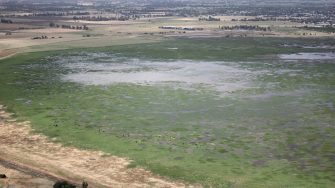
Date: Thursday, October 22, 2015
Project: Eastern Australian Waterbird Survey
Observer - Richard Kingsford
Another lovely cool morning. We started by surveying two lakes near Griffith. One was Barrenbox Swamp. This large wetland is now highly modified and degraded. It takes water from irrigation areas and its flat lake bed was considerably altered by the construction of levees which has reduced the area flooded and the value of the lake for waterbirds. Deep waters do not favour waterbird – they need the shallow water areas for feeding.
Video 1. Barrenbox Swamp is highly modified but is one of the few wetlands with water.
We then continued and surveyed more rice areas. These large shallow water areas seldom have birds, given they are primarily agricultural without the diversity of food and habitats in a natural wetland.
Video 2. Rice fields are not well suited as waterbird habitats even though they have large areas of shallow water.
The Riverina wetlands of international importance or Ramsar sites, Tuckerbil Swamp and Fivebough Swamp were next on the list. Tuckerbil had little water and only a few birds while Fivebough is much larger and had a few thousands birds, mostly grey teal, pied stilts and glossy ibis. It was only about 40% full but it is regularly an important site for waterbirds.
Photo 1. Fivebough Swamp near Leeton always supports large numbers of waterbirds, even though only about 40% full.
Photo 2. Grey teal flew off in their hundreds when we did our survey.
We kept surveying east towards Sydney with our final wetlands on the Great Dividing Range around Moss Vale but we didn’t get that far. Low cloud, rain and generally poor visibility started to threaten and so we stopped at Boorowa and flew back to Sydney at a high level. We will go back in later weeks and ‘finish off’ this part of the survey.
